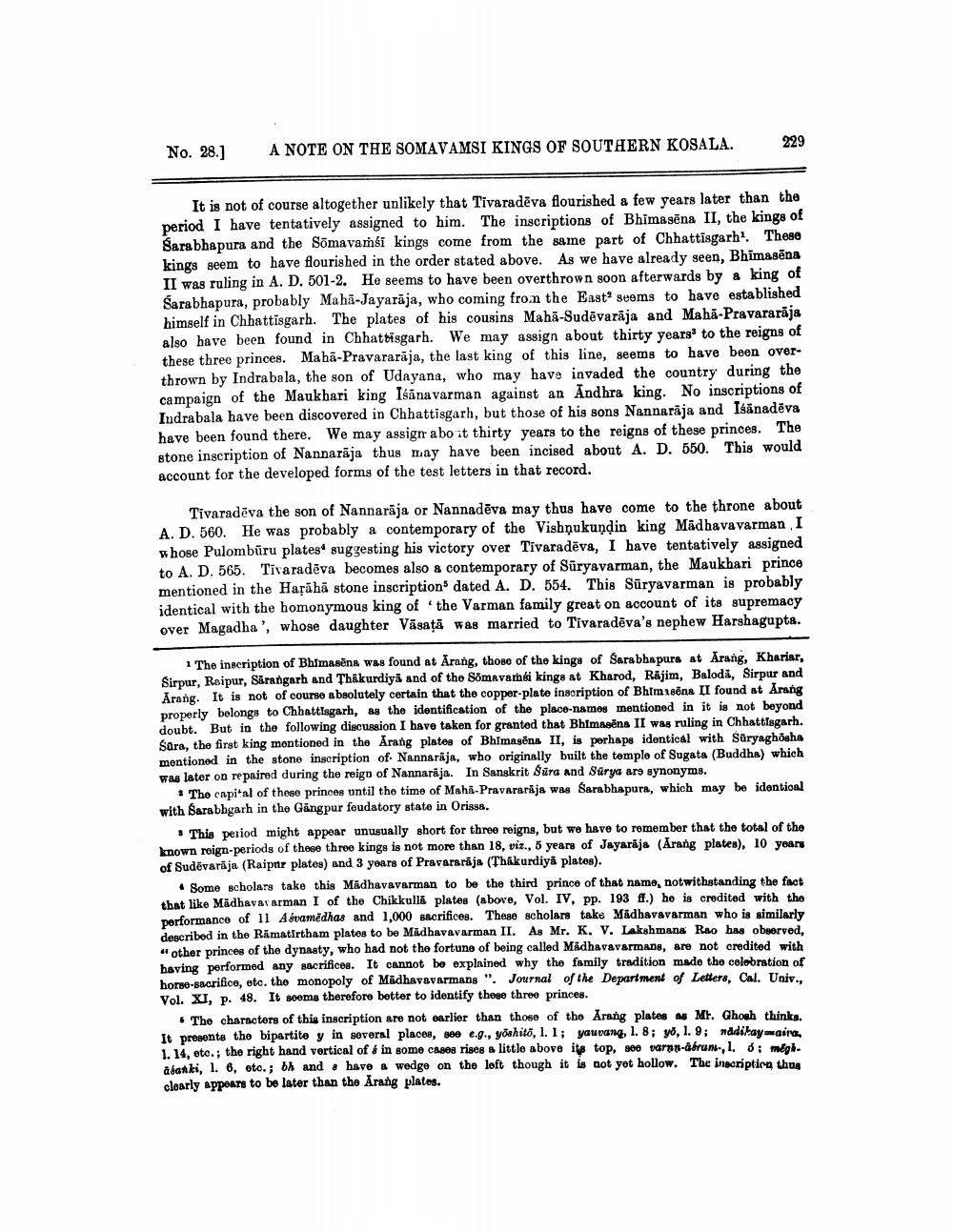________________
No. 28.]
A NOTE ON THE SOMAVAMSI KINGS OF SOUTHERN KOSALA.
229
It is not of course altogether unlikely that Tivaradēva flourished a few years later than the period I have tentatively assigned to him. The inscriptions of Bhimasena II, the kings of Sarabhapura and the Sõmavam i kings come from the same part of Chhattisgarh'. These kings seem to have flourished in the order stated above. As e have already seen, Bhimasēna II was ruling in A. D. 501-2. He seems to have been overthrown soon afterwards by a king of Sarabhapura, probably Maha-Jayarāja, who coming from the East guems to have established himself in Chhattisgarh. The plates of his cousins Mahā-Sudēvarāja and Mahā-Pravararāja also have been found in Chhattisgarh. We may assign about thirty years to the reigns of these three princes. Maha-Pravararāja, the last king of this line, seems to have been overthrown by Indra bala, the son of Udayana, who may have invaded the country during the campaign of the Maukhari king Isänavarman against an Andhra king. No inscriptions of Indrabala have been discovered in Chhattisgarh, but those of his sons Nannarāja and Isänadēva have been found there. We may assignr abo it thirty years to the reigns of these princes. The stone inscription of Nannarāja thus may have been incised about A. D. 550. This would account for the developed forms of the test letters in that record.
Tivaradēva the son of Nannarāja or Nannadēva may thus have come to the throne about A. D. 560. He was probably a contemporary of the Vishņukuņțin king Madhavavarman I whose Pulombūru plates suggesting his victory over Tivaradēva, I have tentatively assigned to A. D. 565. Tivaradēva becomes also & contemporary of Suryavarman, the Maukhari prince mentioned in the Hasāhā stone inscription dated A. D. 554. This Sūryavarman is probably identical with the homonymous king of the Varman family great on account of its supremacy over Magadha', whose daughter Vāsață was married to Tivaradēva's nephew Harshagupta.
1 The inscription of Bhimasena was found at Arang, those of the kings of Sarabhapura at Arang, Kharisr, Sirpur, Raipur, Sārangarh and Thakurdiya and of the Sõmavami kings at Kharod, Räjim, Baloda, Sirpur and Arang. It is not of course absolutely certain that the copper-plate inscription of Bhim 18ēna II found at Arang properly belongs to Chhattisgarh, as the identification of the place-names mentioned in it is not beyond doubt. But in the following discussion I have taken for granted that Bhimasēns II was ruling in Chhattisgarh. Sara, the first king mentioned in the Arang plates of Bhimasēna II, is perhaps identical with Süryaghosha mentioned in the stone inscription of Nannarāja, who originally built the temple of Sugata (Buddha) which was later on repaired during the reign of Nannaraja. In Sanskrit Süra and Sarya are synonyms.
The capital of those princes until the time of Maha-Pravararaja was Sarabhapura, which may be identical with Sarabhgarh in the Gangpur feudatory state in Orissa.
* This period might appear unusually short for three reigns, but we have to remember that the total of the known reign-periods of these three kings is not more than 18, viz., 5 years of Jayarāja (Arang plates), 10 years of Sudēvarāja (Raipar plates) and 3 years of Pravararaja (Thakurdiya platos).
• Some scholars take this Madhavavarman to be the third prince of that namo, notwithstanding the fact that like Mädhavavarman I of the Chikkulla plates (above, Vol. IV, pp. 193 ff.) he is credited with the performance of 11 A svamēdhas and 1,000 sacrifices. These scholars take Madhavavarman who is similarly described in the Ramatirtham platos to be Madhavavarman II. As Mr. K. V. Lakshmana Rao has observed, "other princes of the dynasty, who had not the fortune of being called Madhavavarmans, are not credited with having performed any sacrifices. It cannot be explained why the family tradition made the colobration of horse-sacrifice, etc. the monopoly of Madhavavarmans". Journal of the Department of Letters, Cal. Univ., Vol. XI, p. 48. It sooms therefore better to identify these three princes.
The characters of this inscription are not earlier than those of the Arang platos na Mt. Ghogh thinks. It presonte the bipartite y in several places, see e.g., yoshito, 1. 1; yauvang, 1. 8; W, 1. 9; nadihayira 1. 14, etc.; the right hand vertical of 6 in some cases rises a little above its top, see varaa-abrun., 1. 8: mégb. adatki, l. 6, oto; b) and have a wedge on the loft though it is not yot hollow. The inscription thug clearly appears to be later than the Arang plates.




